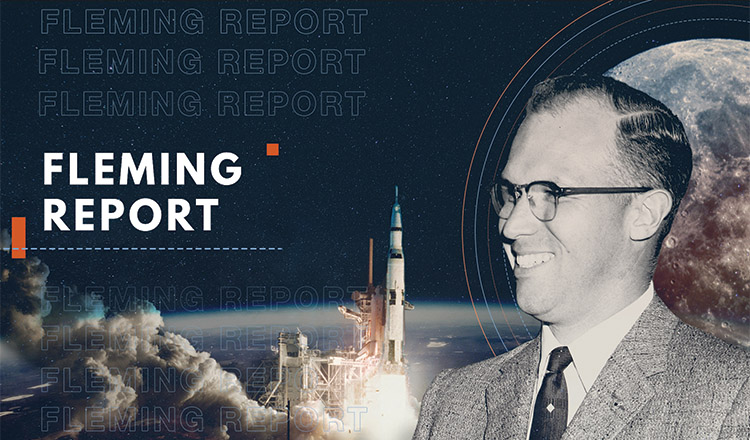Remembering the architect of the Apollo 11 moon landing
You could use many words to describe John F. Kennedy’s promise to put a man on the moon by the end of the 1960s. Daring. Naive. Visionary. Foolhardy.
Just a month and a half before Kennedy’s May 25, 1961, address, the Soviet Union had beaten the United States to become the first to put a man in space. While the president’s plan was thrilling to the American imagination, there was one central problem with it: the plan didn’t exist.
Just weeks earlier, NASA caught rumor of the president’s intentions and started creating the plan’s framework. While the nation looked to the night sky and dreamed, NASA called on William “Bill” Fleming (AAE’43) to help make those dreams become reality.
Fleming was part of Purdue University’s first class of aeronautical engineers. While his name doesn’t command the same recognition as Armstrong or Grissom or Chaffee, it’s a name you should know. Without Fleming, there wouldn’t have been any small steps — much less any giant leaps.
Have you ever scoffed at an unreasonable deadline for a project or report? Imagine being told you have four weeks to create a report detailing “all facets” of the world’s first manned lunar landing. That was exactly Fleming’s task.
“We choose to go to the moon in this decade and do the other things, not because they are easy, but because they are hard, because that goal will serve to organize and measure the best of our energies and skills, because that challenge is one that
-President John F. Kennedy
we are willing
to accept.”
September 12, 1962
His report, A Feasible Approach for an Early Manned Lunar Landing, totaled 510 pages, specified 1,200 tasks to support the landing, estimated related labor needs, and projected the total cost at $12 billion.
“My father played a key role as a director at NASA’s headquarters to manage and oversee the implementation of the plan set forth in this report,” shares Jack Fleming, himself a former engineering student at Purdue before pursuing law. “The tasks identified in the Fleming report became the blueprint for NASA’s plan to land a man on the moon.”
When we think “space race,” we tend to think on a global level. Superpower vs. superpower. A NASA memo titled “Establishment of Ad Hoc Task Group for Manned Lunar Landing Study” helps us understand what exactly the race looked like on a quotidien level — including the supersonic sense of urgency facing NASA employees. Case in point: the memo gives program directors a single day to appoint team members to serve on the above-mentioned task group.
Fleming was the chair of the task group of more than 20 people and a liaison to countless others who contributed. Together, they planned everything, including launch facilities and understanding the effects of radiation and weightlessness on the astronauts.
Beyond logistics, they were also charged with defining the mission’s purpose and goals: “The nature of man’s mission on the moon as it affects the study shall be determined by the Task Group, i.e., the time he is to spend on the moon’s surface and the tasks that he shall perform while there.”
In the 50th anniversary of the first manned lunar landing, we can think of no tribute more touching to Fleming — and the many others behind the scenes — than the words of NASA historian Eugene M. Emme, written to Fleming on the occasion of his retirement from NASA in 1974:
“NASA histories may not be able to essay all the migraines, churnings, turmoil, and, ultimately, the reflective satisfaction of those who were a part of one of the most challenging of human enterprises. Apollo and all the rest of NASA’s historical markings are not stone monuments like the Pyramids, the Acropolis, Notre Dame, or Stonehenge. They are symbolized by people dedicated to do difficult and unprecedented things, and in concert.”

